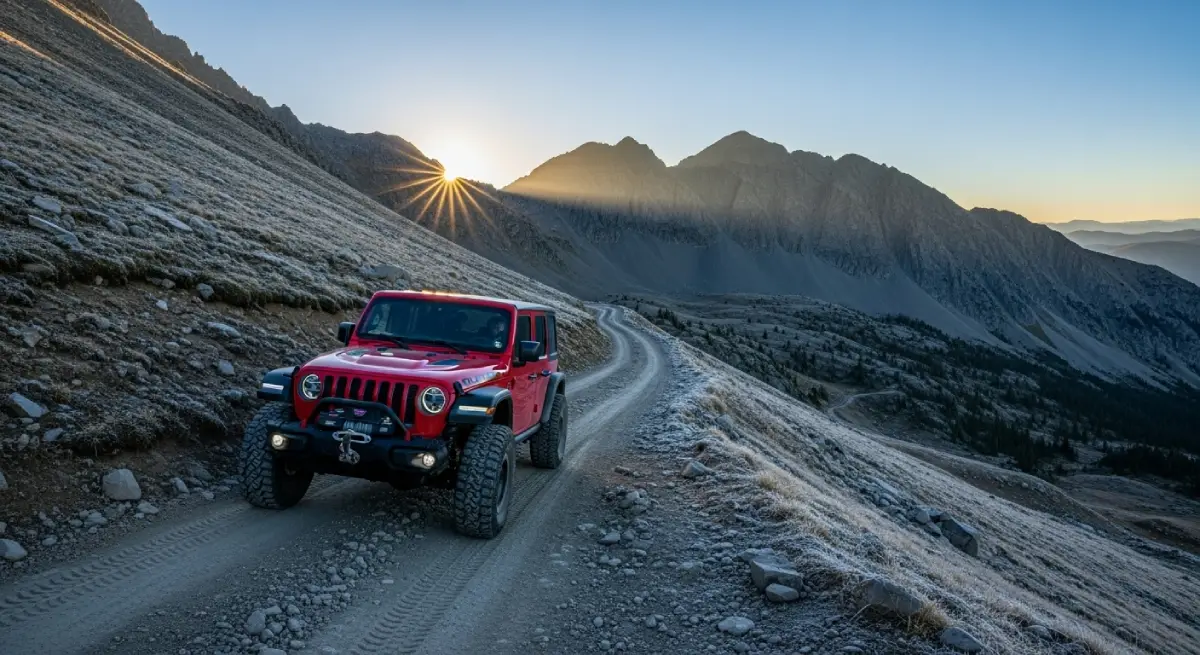Imogene Pass: Colorado's 13,114-Foot Extreme Altitude Challenge That Destroys Sea-Level Assumptions
Here's what altitude charts don't convey about Imogene Pass: at 13,114 feet above sea level, this isn't just another challenging Colorado mountain crossing—it's one of the highest vehicle-accessible routes in North America, where atmospheric pressure drops to levels that cripple unprepared vehicles and affect human performance in ways that most recreational drivers have never experienced.
The numbers alone should inspire respect: you're operating at elevations where commercial aircraft would be descending for landing, where atmospheric oxygen content sits at roughly 60% of sea-level concentration, and where both mechanical and biological systems function at the edge of their designed capabilities.

Imogene Pass connects Ouray and Telluride through terrain that represents the absolute upper limits of where standard 4x4 vehicles can operate successfully. The route climbs through multiple ecosystem zones, crosses the Continental Divide at extreme elevation, and exposes drivers to weather conditions that can shift from summer warmth to winter blizzard within hours. This isn't hyperbole or marketing exaggeration—it's the physical reality of operating at altitudes where atmospheric physics fundamentally change how everything works.
Most people experience less than 10% of what Imogene Pass actually demands because they turn back when altitude effects become undeniable, attempt the crossing in vehicles completely inadequate for extreme elevation operation, or arrive without understanding that preparation requirements for 13,114 feet differ categorically from what works at 10,000 or even 12,000 feet. The difference between tourists who retreat when conditions exceed their assumptions and adventurers who successfully cross this legendary pass comes down to respecting altitude effects that operate according to physics rather than optimism.
Why 13,114 Feet Changes Everything
Imogene Pass elevation places you higher than most peaks in the continental United States. To provide context: you're operating above the summit elevation of every mountain in the Appalachian range, higher than most Colorado 14ers' base camps, and at atmospheric pressure levels where unacclimatized humans experience significant performance degradation even at rest. Now add the demands of technical driving, sustained concentration, and split-second decision-making, and the challenge becomes clear.
What 13,114 feet actually means for vehicle operation:
Atmospheric pressure approximately 35-40% lower than sea level conditions
Naturally aspirated engines producing 40-45% less power than rated output
Cooling system efficiency reduced precisely when increased heat generation demands more capacity
Fuel mixture compensation creating rich conditions that decrease efficiency and increase consumption
Tire pressure differentials affecting handling and traction characteristics significantly
Boiling points for all fluids reduced, creating overheating risks at lower temperatures
Human performance at extreme altitude:
Oxygen availability at approximately 60% of sea level concentration
Cognitive function impairment affecting judgment and reaction time by 25-35%
Physical coordination degradation when precise vehicle control is required
Rapid fatigue accumulation during sustained mental and physical effort
Altitude sickness symptoms possible even in healthy individuals without acclimatization
Stress response amplification when technical challenges compound physiological stress
The compounding problem: As altitude affects your vehicle's capability to perform, it simultaneously degrades your ability to compensate through skilled driving. The challenges increase while your capacity to meet them decreases, creating situations where inadequate preparation leads to failures that wouldn't occur at lower elevations.
The Technical Reality of America's Highest Crossings
Imogene Pass combines extreme altitude with technical terrain that would be challenging at any elevation. The route includes sustained steep grades, rock gardens requiring precise navigation, off-camber sections, and exposure where mistakes become highly visible. At 13,114 feet, these challenges compound exponentially because every technical demand occurs while both driver and vehicle operate at significantly reduced capability.
The Sustained Climbing Challenge at Extreme Altitude
The climb to Imogene Pass summit involves sustained grades that would stress vehicles at sea level. At extreme altitude where engines produce 40-45% less power, these same grades become genuinely difficult for vehicles that handle lower-elevation challenges easily. The continuous demand prevents recovery between sections, testing cooling systems, transmission durability, and driver endurance in ways that shorter climbs never approach.
Sustained grade management at 13,000+ feet:
Maintain speeds that balance forward momentum with overheating prevention
Use low-range gearing exclusively to reduce stress on already-overworked systems
Monitor all temperature gauges continuously—oil, coolant, transmission temperatures
Plan stops strategically at safe locations rather than reactive emergency situations
Accept that progress will be slower than at lower elevations regardless of vehicle capability
Technical Rock Sections at Reduced Performance
Rock gardens and technical obstacles that might be straightforward at 10,000 feet become significantly more challenging at Imogene Pass elevation. The reduced power output limits your ability to maintain momentum through obstacles, while altitude effects on your coordination and judgment affect line selection and throttle control precision.
Rock navigation at extreme altitude:
Pre-identify lines more carefully because reduced power limits recovery options
Accept longer obstacle negotiation times due to reduced capability across all systems
Use spotter assistance more extensively as altitude affects spatial judgment
Understand that what seems manageable may exceed current capability at this elevation
Off-Camber Exposure Sections
Imogene Pass contains off-camber sections where vehicle tilt combines with exposure that makes any loss of control highly consequential. At extreme altitude where cognitive function and physical coordination are impaired, these sections demand extra caution and conservative line selection that prioritizes safety over speed or efficiency.
Weather Patterns at 13,114 Feet
Imogene Pass weather operates on extreme altitude physics where conditions can transition from clear summer warmth to winter storm conditions with remarkable speed. The elevation places you above most weather systems that affect lower terrain, but exposes you to atmospheric conditions that develop at altitude and sweep across the Continental Divide with minimal warning.
Seasonal Access Windows
Summer optimal period (July-September): The only season when Imogene Pass is reliably accessible, though "summer" at 13,114 feet means conditions that would qualify as winter at lower elevations. Morning starts before 9 AM provide the best stability before afternoon heating triggers storm development.
Fall rapid closure (September-October): Early winter storms can close Imogene Pass suddenly and completely, with snow accumulation that makes the route impassable within hours. Weather monitoring becomes critical as seasonal transition accelerates and windows of safe passage narrow dramatically.
Winter complete closure (October-June): Snow depths at Imogene Pass summit regularly exceed 15-20 feet, making the route completely impassable for any vehicle. Winter conditions persist well into late spring at this elevation, with access typically not possible until July.
Spring non-existent: At 13,114 feet, there is no spring season in any traditional sense. The transition goes from winter (deep snow, impassable conditions) to brief summer (accessible but with afternoon storm threats) with minimal gradual warming period between.

Daily Weather Evolution
Morning stability (6 AM - 10 AM):
Coldest temperatures but most stable atmospheric conditions
Clear visibility before cloud development obscures views and creates hazards
Minimal thunderstorm probability for safer crossing attempts
Hard-frozen surfaces providing better traction than afternoon soft conditions
Midday transition (10 AM - 1 PM):
Rapid temperature increase as solar heating affects exposed terrain
Cloud development beginning as moisture rises and condenses at altitude
Weather patterns becoming less predictable as atmospheric instability increases
Window for safe crossing beginning to close as storm probability rises
Afternoon danger period (1 PM - 6 PM):
Thunderstorm development highly probable with dangerous lightning exposure
Temperature drops possible as systems move through, creating hazardous conditions
Visibility reduction from clouds and precipitation affecting navigation
Significantly increased risk making afternoon crossings inadvisable
The altitude weather reality: At 13,114 feet, you're in the zone where weather creates itself through atmospheric dynamics. Conditions that seem stable can deteriorate within 20-30 minutes as temperature differentials drive convective activity that spawns storms with remarkable speed.
Historical Mining Significance
Imogene Pass preserves remnants of mining operations that demonstrate the extraordinary determination and engineering capability required to establish industrial operations at extreme altitude. The historical context provides perspective on modern challenges—if 19th-century miners could move heavy equipment across this terrain using animal power and determination, modern 4x4 vehicles should have advantages, yet the fundamental challenges remain unchanged.
The Tomboy Mine Legacy
The Tomboy Mine, located near Imogene Pass at extreme altitude, represents one of Colorado's most significant high-altitude mining operations. At its peak, this mine supported a community of workers living and operating at elevations where human physiology struggles to maintain basic function. The ruins and artifacts provide educational opportunities while demonstrating that what seems impossible can be achieved with appropriate preparation and determination.

Historical lessons for modern adventurers:
Extreme altitude operations require exceptional preparation and redundant systems
Weather awareness and flexible timing determine success versus expensive failure
Self-sufficiency becomes mandatory when isolation is measured in days, not hours
Respect for environmental forces that operate on physical principles, not human schedules
Vehicle Requirements for Extreme Altitude Operation
Imogene Pass demands vehicle capabilities specifically addressing extreme altitude challenges that go beyond standard off-road modifications. Understanding these requirements prevents situations where inadequate preparation leads to failures that wouldn't occur at lower elevations with identical vehicles and terrain.
High-Altitude Engine Performance Systems
Naturally aspirated engine limitations at 13,114 feet:
Power output reduced to approximately 55-60% of sea-level rating
Fuel mixture compensation creating rich conditions and reduced efficiency
Cooling demands increased while cooling efficiency decreased by altitude
Performance inadequate for sustained technical climbing without proper gearing
Turbocharged engine advantages:
Power output maintained at approximately 75-85% of sea-level performance
Better fuel efficiency through improved combustion at reduced atmospheric pressure
Enhanced ability to maintain momentum through technical sections
Reduced transmission stress due to better power delivery at altitude
Essential high-altitude modifications:
Enhanced cooling systems with 40-50% greater capacity than stock specifications
Low-range gearing ratios of 4.5:1 or lower to compensate for reduced power
Transmission coolers rated for sustained mountain operation under load
Real-time monitoring systems for all critical temperatures
Ground Clearance and Protection
Minimum specifications for Imogene Pass:
10+ inches ground clearance measured at lowest point with full load
Approach angles exceeding 35 degrees for technical rock navigation
Departure angles over 30 degrees for obstacle clearing without contact
Comprehensive skid plate protection covering all vulnerable components
Emergency Preparedness Systems
Required emergency equipment for 13,114 feet:
Satellite communication devices (cell service completely unreliable)
GPS navigation with offline maps for signal loss situations
Emergency shelter rated for below-freezing conditions (possible any month)
Oxygen supplementation for altitude sickness emergencies (serious consideration)
Extensive first aid supplies appropriate for high-altitude medical issues
Why Professional Rental Services Are Critical for Imogene Pass
Attempting Imogene Pass in personal vehicles creates extreme risks that professional rental services mitigate: insurance exclusions for extreme altitude operation, lack of purpose-built modifications for 13,114-foot challenges, and absence of current condition intelligence that determines safe crossing windows versus dangerous attempts.
Purpose-Built Fleet for Extreme Altitude
Cliffhanger Jeep Rentals operates vehicles designed specifically for extreme altitude San Juan challenges, with cooling systems, gearing, and modifications proven through successful Imogene Pass crossings rather than theoretical specifications that sound adequate but fail under real-world stress at 13,114 feet.
Fleet specifications for America's highest crossings:
Turbocharged engines maintaining adequate power output at extreme altitude
Heavy-duty cooling systems designed specifically for sustained 13,000+ foot operation
Low-range gearing appropriate for technical terrain at 40-45% power reduction
Comprehensive armor protection based on actual damage patterns from this specific route
Emergency equipment positioned for self-sufficiency at extreme altitude
Critical Local Expertise
Real-time condition intelligence: Professional operations maintain hour-by-hour awareness of weather patterns, route conditions, and temporary hazards that determine whether crossing attempts are advisable on specific days.
Altitude acclimatization guidance: Experienced guides understand the time requirements for sea-level visitors to acclimatize sufficiently for 13,114-foot exposure and can recommend preparation strategies that reduce altitude sickness risks.
Route timing optimization: Knowledge about optimal crossing windows, turnaround decision points, and emergency bailout strategies that guidebooks don't provide but determine success versus dangerous situations.
Comprehensive High-Altitude Insurance
Personal vehicle insurance universally excludes coverage for extreme altitude off-road operation, leaving owners financially responsible for recovery costs that can reach tens of thousands of dollars when vehicles fail or become stranded at 13,114 feet.
Professional insurance advantages:
Coverage designed specifically for extreme altitude off-road activities
Emergency extraction services via helicopter when ground recovery isn't feasible
No personal financial exposure for mechanical failures that occur despite appropriate use
Peace of mind that allows focus on the experience rather than financial risk calculation
Planning for Extreme Altitude Success
Successful Imogene Pass crossings require planning that acknowledges extreme altitude creates categorically different requirements from lower-elevation adventures. The preparation level that works for 10,000-foot passes proves inadequate when operating at 13,114 feet where physics fundamentally changes how everything functions.
Acclimatization Requirements
Sea-level visitors need minimum 2-3 days at 8,000+ feet before attempting Imogene Pass. Immediate ascent to 13,114 feet creates high probability of altitude sickness symptoms that affect judgment and physical capability when technical driving demands peak performance.
Progressive altitude exposure strategy:
Day 1-2: Arrive at 8,000-9,000 feet (Ouray or Telluride), rest and hydrate extensively
Day 3: Short excursions to 10,000-11,000 feet to assess altitude tolerance
Day 4: Imogene Pass attempt if feeling strong with no altitude symptoms
Hydration: 50-100% more water intake than normal to combat altitude dehydration
Optimal Timing Strategy
Peak season window (late July-August): Most reliable conditions with maximum probability of route accessibility and stable weather patterns. Even during optimal season, morning-only crossings recommended.
Early season risks (July): Snow may remain at highest elevations while route is technically open. Variable conditions require flexibility and willingness to turn back.
Late season dangers (September): Weather becomes increasingly unstable with high probability of sudden winter storm development that can strand vehicles at extreme altitude.
Group Configuration
Optimal team: 2 vehicles minimum, 3 maximum
Two vehicles provide essential redundancy at extreme altitude
Three vehicles offer additional safety without creating coordination challenges
Solo attempts are extremely inadvisable given catastrophic failure consequences
Required experience distribution:
At least one team member with previous 12,000+ foot driving experience
Understanding of altitude sickness recognition and emergency response protocols
Mechanical knowledge for field repairs at elevation where assistance is impossible
Emergency Preparedness for 13,114 Feet
Critical emergency equipment:
Satellite communication (cell service non-existent at summit)
Emergency bivouac supplies for unexpected overnight at extreme altitude
Cold weather gear for temperatures that can drop to freezing any month
Extensive food and water for delays that can extend to multiple days
Altitude sickness medication (prescription Diamox recommended)
Comprehensive first aid including oxygen if possible
Environmental Responsibility at Extreme Altitude
Imogene Pass crosses alpine tundra ecosystems that exist only above treeline where growing seasons span mere weeks annually. Vegetation damage at this elevation requires literally decades or centuries for recovery due to extreme environmental conditions that limit growth rates to near-zero.

Alpine Tundra Protection
Critical protection requirements:
Absolute adherence to designated routes—no off-trail travel ever
Zero waste tolerance: pack out everything including the smallest items
No camping above treeline where ecosystem damage becomes permanent
Noise minimization during wildlife sensitive periods
Access Preservation Through Responsibility
Imogene Pass access depends on continued demonstration that recreational users can operate responsibly at extreme altitude. Inappropriate use threatens closure of one of North America's most spectacular high-altitude routes.
The Reality of Imogene Pass Achievement
Imogene Pass rewards exceptional preparation while providing immediate feedback about the difference between adequate equipment and dangerous inadequacy. Success requires understanding that extreme altitude creates challenges that differ categorically from what works at 10,000 or even 12,000 feet.
What 13,114-foot success demands:
Vehicle modifications specifically addressing extreme altitude performance requirements
Altitude acclimatization appropriate for extreme elevation exposure
Weather awareness and flexible timing for rapidly changing high-altitude conditions
Emergency preparedness for situations where rescue may take days at extreme altitude
Physical and mental readiness for challenges that compound through altitude effects
Making the Commitment to America's Highest Crossing
Imogene Pass represents the absolute upper limit of recreational 4x4 adventure in North America. The route tests every assumption about capability while providing experiences that exist nowhere else accessible by vehicle. Successfully crossing at 13,114 feet means you've operated at altitudes where atmospheric conditions challenge both human and mechanical systems at fundamental levels.
Building toward Imogene Pass readiness:
Progressive altitude exposure through increasingly high passes (10,000, 11,000, 12,000+ feet)
Vehicle preparation specifically for extreme altitude rather than generic off-road use
Altitude sickness awareness and acclimatization protocol understanding
Emergency response training for high-altitude medical and mechanical situations
Mental preparation for challenges that affect both confidence and capability
The Professional Advantage: Cliffhanger Jeep Rentals
The choice between attempting Imogene Pass in personal vehicles versus partnering with professional services often determines whether the experience becomes ultimate achievement or expensive failure at altitudes where mistakes carry extreme consequences.
Professional service advantages:
Purpose-built vehicles proven at 13,114 feet, not just theoretically capable
Local expertise about acclimatization, timing, and current conditions
Insurance coverage for extreme altitude operation that personal policies exclude
Emergency support systems appropriate for America's highest vehicle routes
No personal financial exposure for the mechanical failures that extreme altitude creates

The Bottom Line: Earning Your Place at 13,114 Feet
Imogene Pass doesn't care about your vehicle cost, modification list, or driving confidence. It presents challenges that operate on atmospheric physics and geological forces that have existed for millions of years and will continue long after every vehicle currently crossing this pass has been scrapped.
At 13,114 feet, you're operating at the extreme edge of where internal combustion engines function and where human physiology maintains adequate performance. The margin between success and failure becomes razor-thin, determined by preparation quality rather than determination intensity.
Whether you choose to develop personal capabilities for this ultimate crossing or partner with professional services providing proven equipment and expertise, success depends on respecting forces that operate on physical principles unaffected by confidence or technology.
The most rewarding Imogene Pass experiences come from understanding what 13,114 feet actually means and meeting those challenges through exceptional preparation rather than discovering the limits of inadequacy through expensive failure at America's highest vehicle-accessible elevations.
Ready to cross one of North America's highest vehicle routes? Cliffhanger Jeep Rentals provides the extreme-altitude vehicles, acclimatization guidance, and emergency support systems that transform Imogene Pass from theoretical possibility into successful achievement at 13,114 feet above sea level.
Experience Imogene Pass with confidence through Cliffhanger Jeep Rentals—where every vehicle is built for challenges that separate ultimate achievement from catastrophic failure at extreme altitude.


